Relationship between quality of life and adolescent glycolipid metabolism disorder:A cohort study
2022-07-15XiaoHuaLiangYangLingRenXiaoYueLiangJingYuChenPingQuXianTang
lNTRODUCTlON
The increased prevalence of glucolipid metabolic disorders (GLMDs) in children and adolescents has a well-established association with cardiovascular diseases (CVDs) and type 2 diabetes (T2D) in adulthood[1]. Therefore, it is important to increase our understanding of the risk factors for GLMD during childhood and adolescence. Previous studies have illustrated that risk factors for GLMD in children include unhealthy dietary habits[2], genetic factors[3,4], poor prenatal exposure to high maternal fasting blood glucose (FBG) levels[5], and gestational diabetes. Overall, conclusions about insulin resistance (IR) and quality of life (QoL) are controversial. The results of Schlotz
[6] showed that IR is associated with lower health-related QoL only in physical health domains[6]. However, a cohort study reported that participants with IR had deteriorated health-related QoL involving physical functioning, emotional role limitations, social functioning, pain, and general health perception, and a more significant correlation was found in males[7]. Several previous studies[8,9] have found that limited trials have reported health-related QoL (HRQoL) in diabetes mellitus, and diabetes affects several dimensions of QoL, such as physical, social well-being, and emotional, compared with a control group[10,11]. Additionally, the primary intervention of pravastatin plus intensive dietary advice might improve the QoL of patients with hyperlipidaemia[12,13]. Several intervention trials[10,14,15] of patients with T2D found disease special-QoL and HRQoL to be improved after treatment, accompanied by decreased FPG, triglyceride (TG), and insulin levels. A systematic review also illustrated that diabetes self-management education may improve the QoL of diabetes by decreasing glycosylated haemoglobin (HbA1c) levels[11]. Therefore, previous conclusions suggest that hyperlipidaemia and impaired fasting glycaemia may impact QoL. Moreover, a study showed that lower QoL impacts the ability to achieve a good HbA1c level[16]. Diverse QoL survey tools have been used in previous studies, with most of these assessment tools being focused on disease-specific QoL[11,17], whereas there are few scales for measuring the global health or general health of healthy subjects[7]. QoL includes multidimensional terms, which represent satisfaction with life status and describe a subject’s functioning in physical, emotional, and social domains. Little evidence about the relationship between QoL and GLMD has been reported, especially in children and adolescents, which is an important stage of growth.
She ran a small shop at a flea2 market and collected old clothes and some other things to sell for the money we needed. Once during elementary school, it was field day, and my mom came.I was so embarrassed and wondered how could she do this to me?I threw her a hateful look and ran out. The next day at school, my schoolmates asked me, your mom only has one eye?! and taunted3 me.
To our knowledge, there are no studies exploring the correlation between QoL and GLMD in healthy children aged 10-14 years from a rural-urban cohort study. The hypothesis of this study is that QoL affect GLMD in children and adolescents. The aim of this cohort study was to explore the correlation of QoL scores with GLMD in adolescents, providing an excellent opportunity to identify independent risk factors for GLMD after adjusting for multiple variables, such as perinatal variables, socioeconomic status (SES), anthropometric measures, and other biochemical indexes.
MATERlALS AND METHODS
Subjects
Two-stage stratified cluster sampling was used to select children from urban and rural areas of Chongqing; then, two regions
county were randomly chosen; and finally, all children living in the selected region were informed and included if they were satisfied the inclusion criteria. In addition, a bidirectional cohort in which retrospective and prospective variables were adjusted was used to evaluate the relationship between QoL and GLMD. At baseline, children who met all the following criteria were recruited:(1) Aged 6-9 years in 2014; (2) Resided in the selected areas for more than 6 mo; (3) Did not have serious diseases (
, nephropathy, CVD, or cancer); and (4) Consent both from the parents and children for participation. At baseline, all participants in grades 1 and 2 were recruited mainly from two elementary schools. The class head teacher delivered questionnaires to children who signed informed consent forms, and the children took the questionnaires home and completed them with their parents, after which the teacher collected the questionnaires. Two thousand one hundred and thirty-six children with venous blood samples were analysed in this study. After excluding 117 children without FBG or insulin data and 60 children without QoL information, 1959 children with complete data were analysed (Figure 1). This study was approved by the Institutional Review Board of the Children’s Hospital of Chongqing Medical University, and all subjects and their parents/guardians signed informed consent forms.

Demographic variables
Demographic information and SES (parents' occupation and education level, and family income) were collected. Bachelor’s and master’s degrees were combined, as there were few parents with the latter. Therefore, parental education level was measured on a four-point scale [≤ 9 years (elementary and middle school), 9-12, 12-15, and > 15 years]. Perinatal variables included maternal obesity and maternal increased weight during pregnancy. Family history of obesity or CVD was investigated using a selffilled questionnaire. In addition, sleeping quality and dietary intake of vegetables, red meat, and salt were surveyed; the detailed protocol was published in a previous paper[18,19].
The questionnaire is valid and reliable, has been used in more than 20000 children, has been modified several times after each survey, and has been described in detail in our previous publications[19-21]. The questionnaire included information on demographics, perinatal status, SES, dietary intake, physical activity, and sleep quality; it was completed both by the children and their parents or guardians according to the protocol.
Physical examination
Anthropometric indexes of height, weight, and waist circumference were measured by well-trained paediatric nurses, and the detailed protocol for these measurements has been introduced in our previous papers[19,22,23].
Biochemical indexes
Venous blood (3 mL) was drawn in the morning after at least 12 h of fasting from subjects who provided informed consent[24]. FBG, total cholesterol (TC), high density lipoprotein cholesterol (HDL-C), low density lipoprotein cholesterol (LDL-C), TGs, fasting insulin (FI), and glycosylated haemoglobin were measured within 2 h after blood draw; details are provided in other publications[19]. In 2019, FI was measured using a Siemens Centaur XP.
But I did. I was so weak my legs trembled. I could never have crossed that squirming deck if Benny hadn t supported me. The kid was stronger than he looked. He helped me down the steps and steered12 me to the bench where Dad was sitting with his head drooping13 on his chest.
QoL questionnaire
The QoL Scale for Children and Adolescents (QLSCA) with 49 items, which is suitable for children aged 7-18 years old, was used to investigate the QoL of children[25]. QLSCA includes four factors and 13 domains, which have been introduced in our previous publication[25]. A four-point scale was used with the QLSCA, with a randomized bidirectional response (positive or negative) item by item to limit the bias of the response. Individual item values were recorded in the same direction prior to analysis.
Response values were summed and normalized to the age-, sex-, and urban-rural-specific norms of Chinese individuals into a score ranging from 0-100 (normalized with a mean of 50 and SD of 10), whereby higher scores represent better QoL[26]. The domain scores and factor scores between males and females are displayed in Table 1.
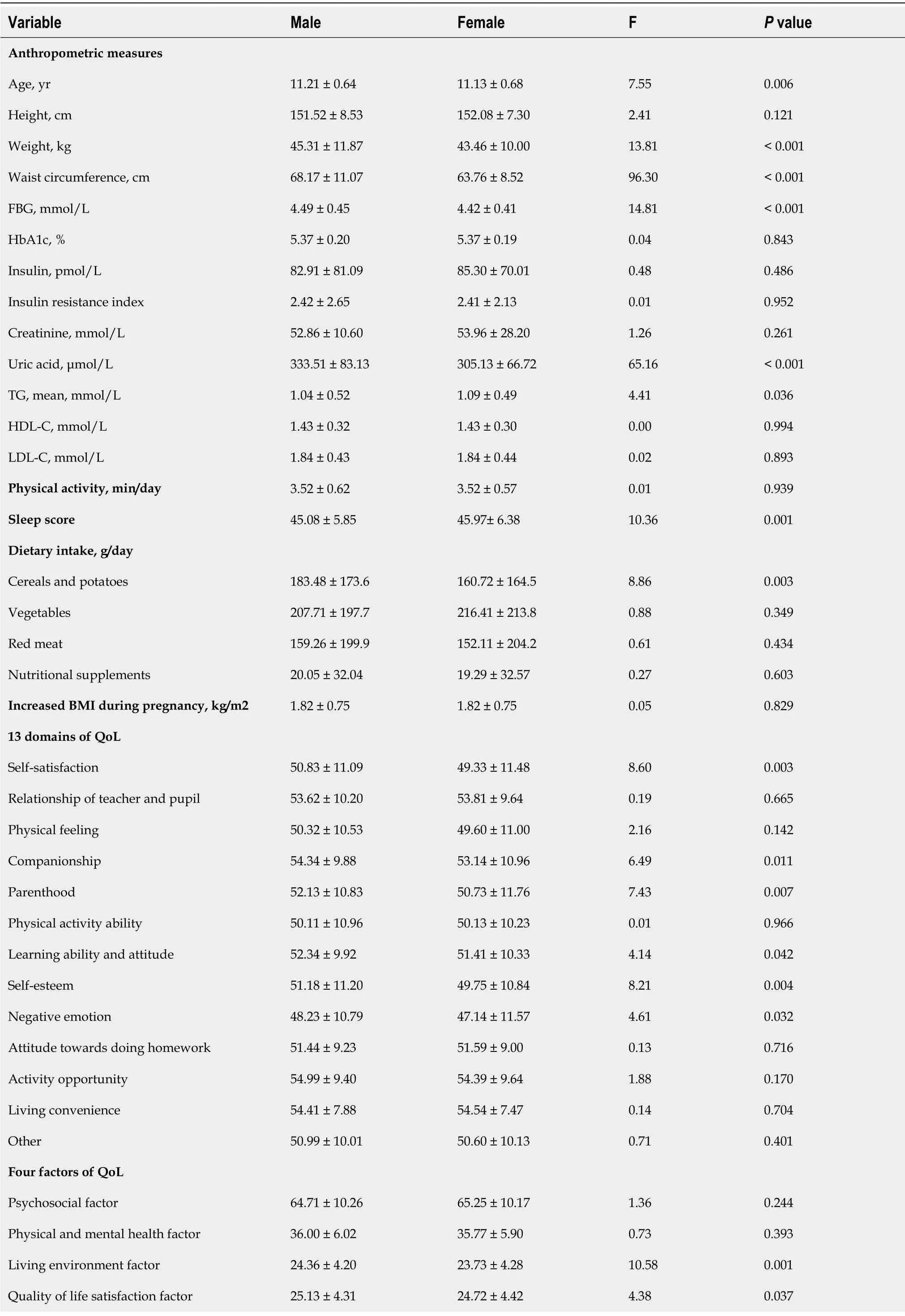
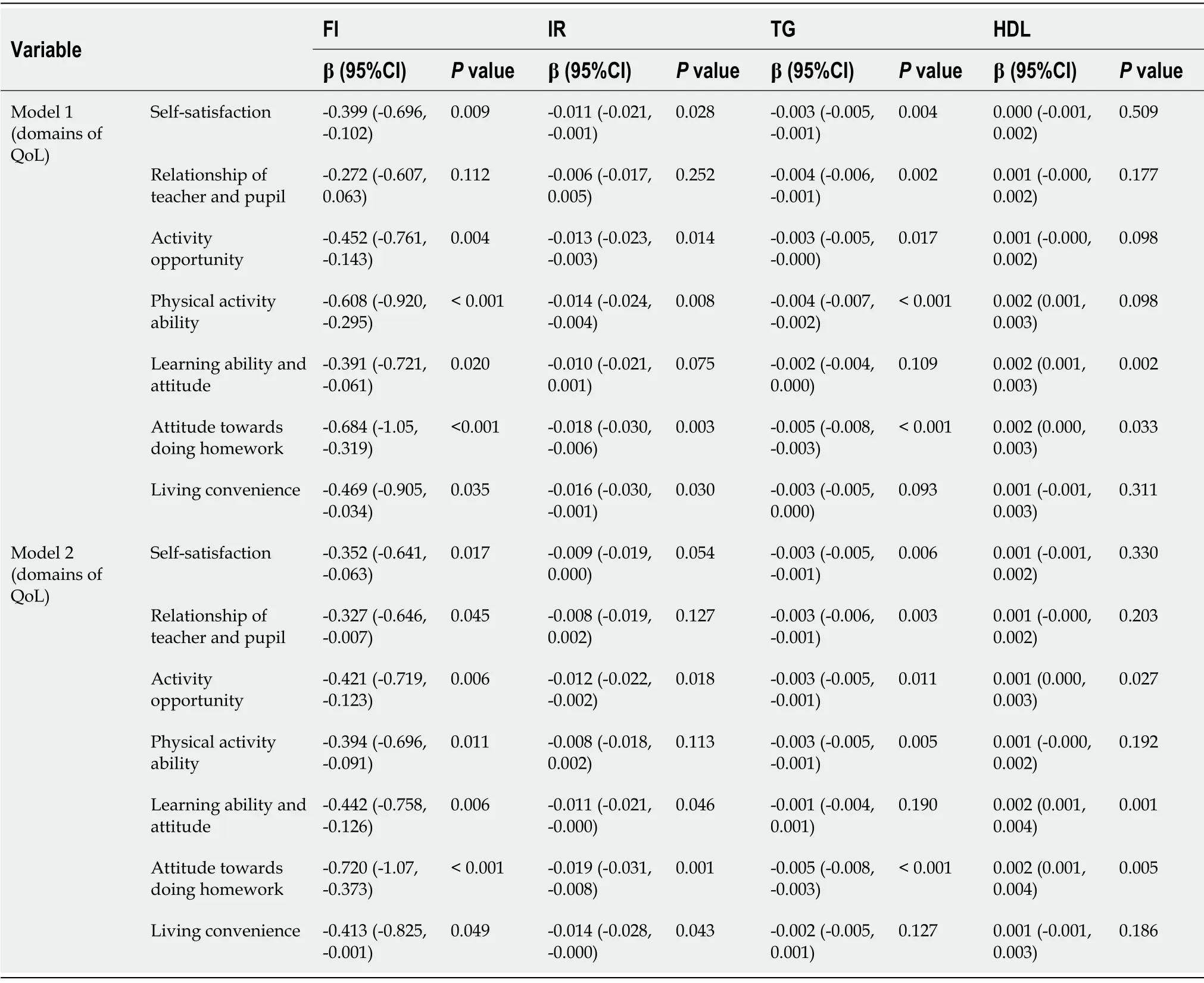

Diagnostic criteria
Children were diagnosed with increased blood glucose if their FBG was ≥ 5.6 mmol/L[27]. Dyslipidaemia was indicated if any one of the following criteria were met[28]:(1) TC ≥ 200 mg/dL; (2) TG ≥ 130 mg/dL; (3) LDL-C ≥ 130 mg/dL; and (4) HDL-C ≤ 40 mg/dL. Moreover, IR was defined by homeostasis model assessment (HOMA)-IR > 3.0[29], which was calculated by the formula (FI mU/L) × (FBG mmol/L)/22.5. Maternal overweight/obesity was defined as a body mass index greater than 24 kg/m
[30]. Maternal pregnancy weight gain was defined by the guidelines of the institute of medicine[31], as gaining 12.5-18.0 kg, 11.5-16.0 kg, 7.0-11.5 kg, and 5.0-9.0 kg for underweight, normal weight, overweight, and obesity, respectively.
Statistical analysis
Continuous variables, such as insulin, HOMA-IR, and TG, which did not conform to a normal distribution, were subjected to natural logarithmic transformation before analyses. The relationship between QoL and GLMD was analysed with a generalized linear model. Two models were used to adjust for covariates:Model 1 adjusted for age and sex, and Model 2 adjusted for covariates of height, weight, vegetable intake, red meat intake, salt intake, sleeping quality, father's education, mother's education, household income, urban-rural areas, maternal increased weight during pregnancy, and maternal obesity, which may reflect the independent effect of QoL on blood glucose and lipid indexes. In addition, a logistic regression model was used to analyse the relationship between QoL and GLMD with two models to adjust for covariates.
The results were analysed with SAS 9.4 software (Copyright
2020 SAS Institute Inc. Cary, NC, United States). An α level of 0.05 was defined as a significant difference.
RESULTS
General characteristics
The general characteristics of the subjects are presented in Table 1. A total of 1956 samples were included. The mean age was 11.21 ± 0.64 years, and 51.53% (1008/1956) were males. The 13 domains, four factors, and total score of QoL, biochemical indexes, and anthropometric, perinatal, and SES variables between males and females are shown in Table 1.
When it was past midnight, and the robbers saw from afar that the light was no longer burning in their house, and all appeared quiet, the captain said, We ought not to have let ourselves be frightened out of our wits; and ordered one of them to go and examine the house.18
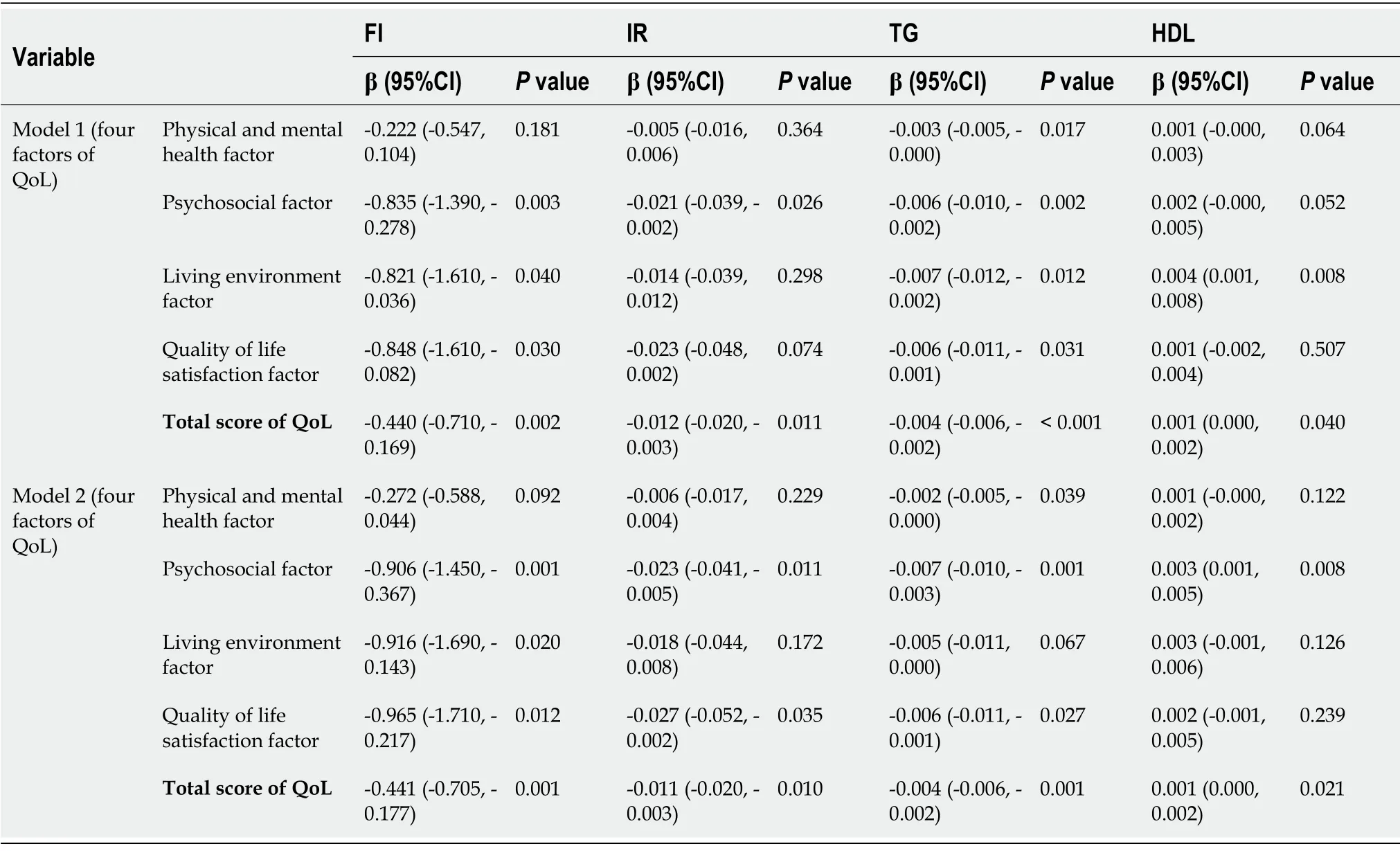
Association between QoL and glycolipid indexes
The prevalence of GLMD and high glycolipid levels are increased in adolescents with features of low QoL scores. Our study adds more evidence about sex difference in the association between QoL and GLMD, and more domains of QoL correlate with GLMD in females.
The effect of QoL on glycolipid metabolism indexes by sex is shown in Supplementary Tables. The results in Supplementary Tables 3 and 4 illustrate the relationship between QoL and indexes (FI, IR, TG, and HDL). Scores of attitude towards doing homework and living convenience were negative for FI, IR, and TG (
< 0.05 or
< 0.001), and the association of attitude towards doing homework with IR/TG was also significant after adjusting for covariates in Model 2 (
< 0.05). Moreover, the relationship between total QoL score and FI/TG was negative (
< 0.05). Higher scores of activity opportunity, physical activity ability, learning ability, and attitude and lower levels of FI, TG, and HDL were found for females (
< 0.05); in Model 2, the score of attitude towards doing homework correlated negatively with IR level (
= 0.018).
In addition, the association between the four factors of QoL and the prevalence of glycolipid metabolism indexes by sex is shown in Supplementary Tables 5 and 6. The relationship between the living convenience score and FBG was negative (
< 0.05). However, significant relationships for females were only found in Model 1.
Association between QoL and GLMD prevalence
The results in Tables 4 and 5 indicated the relationship between QoL and GLMD in adolescents. The attitude towards doing homework domain score was a protective factor for dyslipidaemia [OR (95%CI):0.984 (0.972, 0.995);
= 0.004], and the relationship was significant even after adjusting for covariates [OR (95%CI):0.982 (0.970, 0.994);
= 0.003]. This relationship was also statistically significant in males [OR (95%CI):0.983 (0.968, 0.998);
= 0.031]. However, among females, there were other factors of significance, such as relationship of teacher and pupil [OR (95%CI):0.985 (0.969, 1.001);
= 0.060], activity opportunity [OR (95%CI):0.984 (0.970, 0.998);
= 0.026], and learning ability and attitude [OR (95%CI):0.984 (0.969, 1.000);
= 0.046]. After adjusting for covariates in Model 1 and Model 2, selfsatisfaction, the relationship of teacher and pupil, activity opportunity, physical activity ability, learning ability and attitude, and attitude towards doing homework were protective factors for IR > 3 in all participants and in females, but only the physical activity ability domain score was significant in males [OR (95%CI):0.984 (0.970, 0.999);
= 0.037] in Model 1. Attitude towards the homework domain was a protective factor for FBG in Model 2 for all subjects and females (
< 0.05) (Table 4).
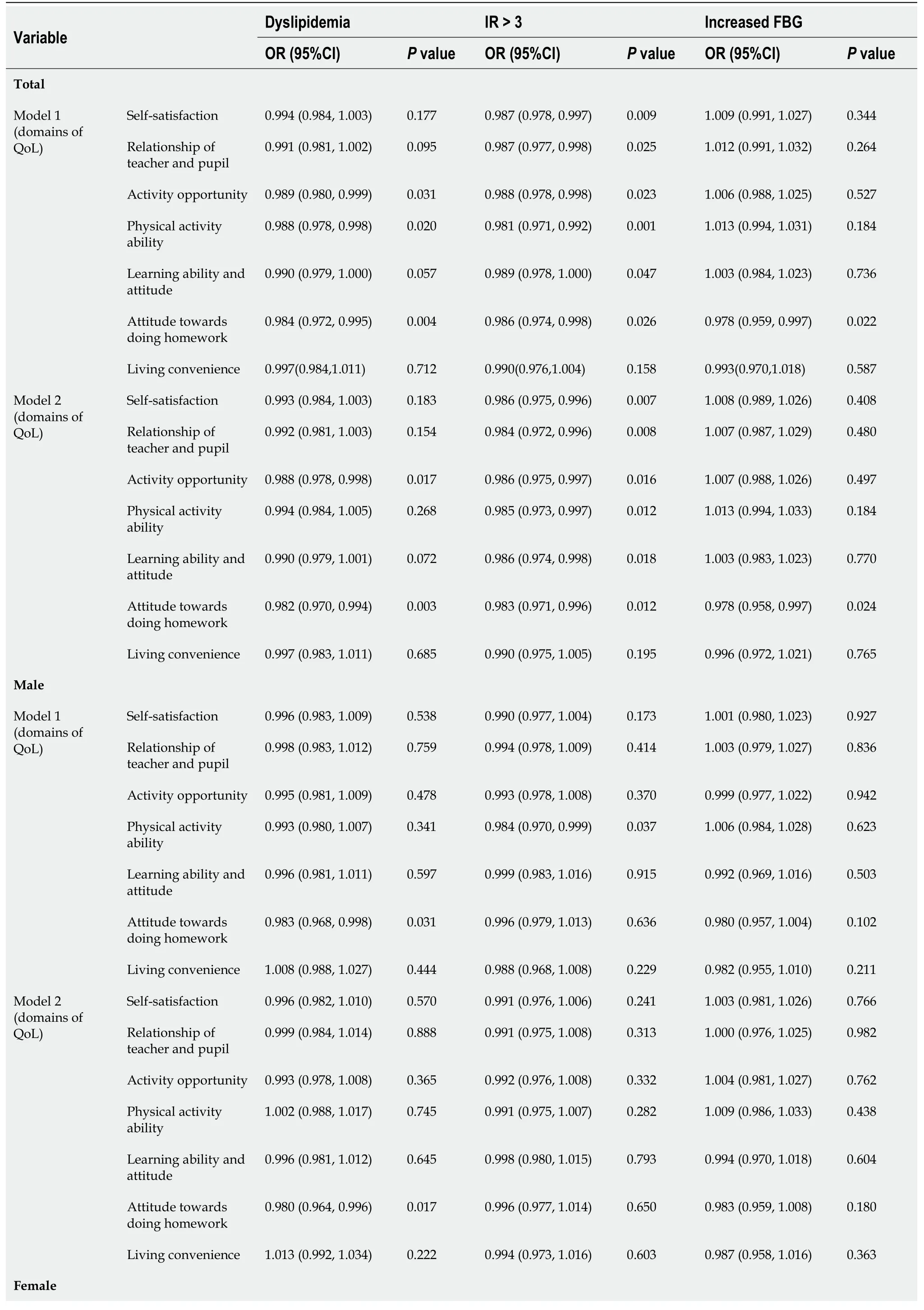

The relationship between the four factors of QoL and the prevalence of GLMD was not significant in males (
0.05). Psychosocial factor [OR (95%CI):0.976 (0.959, 0.994);
= 0.008] [OR (95%CI):0.980 (0.962, 0.998);
= 0.034] and total score of QoL [OR (95%CI):0.990 (0.982, 0.999);
= 0.025] [OR (95%CI):0.988 (0.979, 0.997);
= 0.007] were protective factors for dyslipidaemia and IR > 3, respectively, with statistical significance in the total cohort in Model 1. In addition, higher score of psychosocial factor [OR (95%CI):0.971 (0.946, 0.996);
= 0.024], living environment factor [OR (95%CI):0.952 (0.919, 0.987);
= 0.008], and total score of QoL [OR (95%CI):0.985 (0.973, 0.997);
= 0.014] in females was related to a lower prevalence of dyslipidaemia in Model 2. In Model 2, adjusted for covariates, all factors of QoL were protective factors for IR > 3 (
< 0.05) (Table 5).
#p#Then, with ill words, twelve negroes dragged in a lovely woman, fettered157 on hands and feet and meanly dressed, and they set her down on the bare floor
Oh, my beautiful Tsar s daughter, said Tsar Afron, I grant thee whatever thou mayst wish. Go then and walk where it pleaseth thee, and perchance it will soothe38 thy grief and sorrow at parting from thy father. So he ordered serving-women and all the ladies-in-waiting of the Court to walk with her.
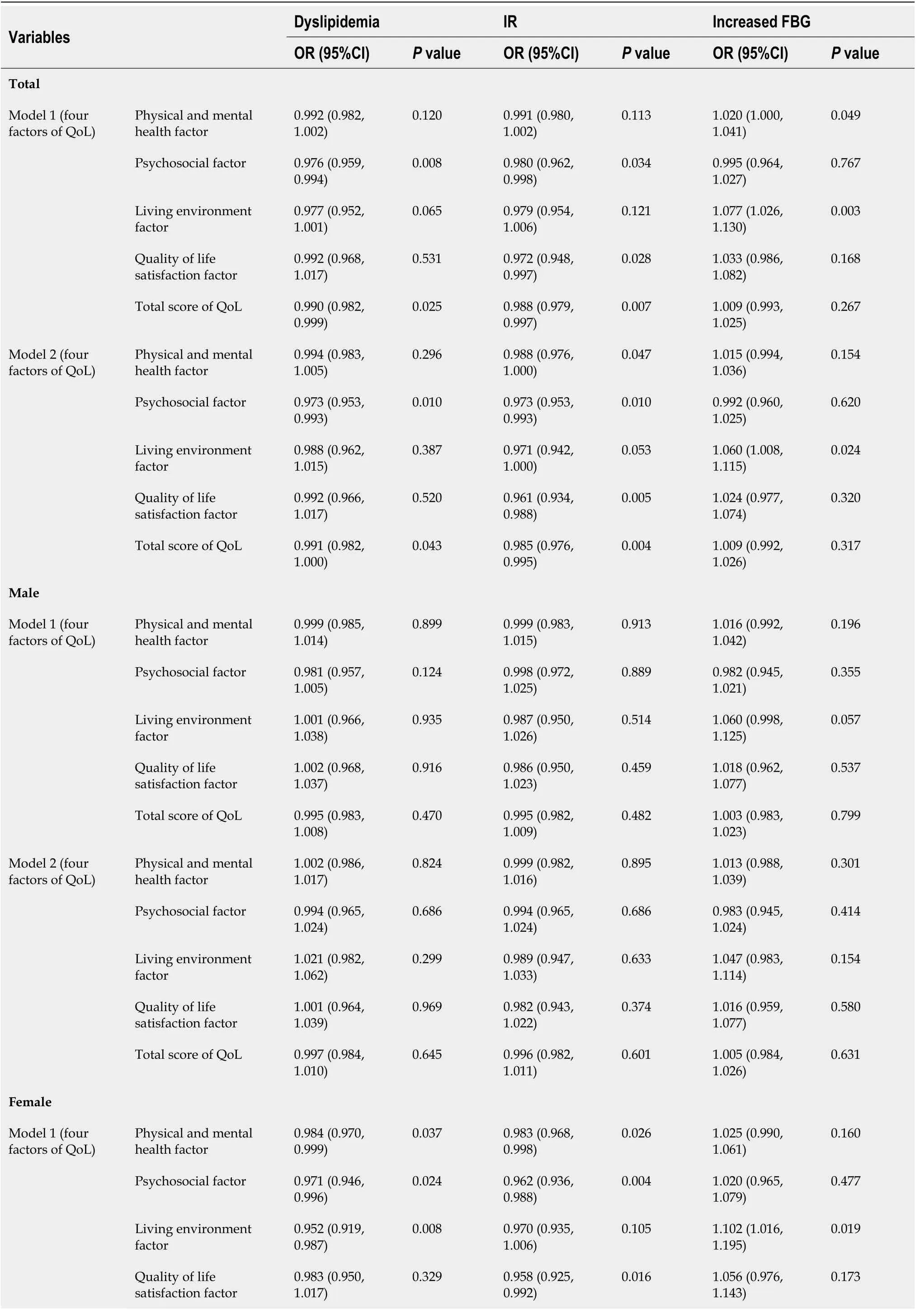

DlSCUSSlON
The aim of this cohort study was to explore the correlation of QoL scores and personality traits with GLMD in adolescents, providing an excellent opportunity to identify independent risk factors for GLMD after adjusting for multiple variables, such as perinatal variables, socioeconomic status, anthropometric measures, and other biochemical indexes.
In conclusion, GLMD prevalence and high glycolipid levels are elevated in adolescents with low QoL scores. To our knowledge, this is the first study to explore the relationship of QoL with glycolipid indexes from a large-sample-size cohort study of adolescents, and the correlation was significant after adjusting for multiple covariates. Our study emphasizes the importance of improving QoL in children and adolescents and provides scientific evidence for educational institutions to improve the educational model to enhance the QoL of school-age children. However, our study illustrates the relationship between QoL and glycolipid indexes from a nearly cross-sectional perspective, and a further welldesigned large-sample-size cohort study or randomized controlled trial study should be conducted to examine the causal relationships.
The association between QoL and GLMD may be impacted by sex. Scores on several domains of QoL are reportedly lower in females than in males[34-37]. Longitudinal studies have shown a significant relationship between weight and QoL only in females[38]. However, one study found that females and males have similar psychological characteristics[39]. Overall, numerous studies have detected significant sex differences in awareness and mental health[40,41]. For instance, in terms of personality, males score higher than females in self-acceptance and autonomy, whereas females score higher than males in personal growth and positive relationships with others[42]. Our study adds more evidence about the sex difference in the association between QoL and GLMD; overall, more domains of QoL correlated with GLMD in females.
Several mechanisms may explain why QoL may impact GLMD. Physical and psychological health and social well-being are encompassed in HRQoL[43]. Previous study results show that an increase in total HbA1c is related to a decrease in QoL[44]. In addition, research has found that better QoL is associated with better healthy dietary patterns and behaviours in children and adolescents[45]. Irrational diets may induce FBG increases. For example, a high-fat diet induces IR, triggering accumulation of diacylglycerol and ceramide levels in the liver and inhibiting the insulin signalling pathway[46]. Some studies have suggested that physical activity and mental health are positively associated with QoL[44]; it is well known that exercise enhances insulin signalling independent of PI3K and that glucose transport and GLUT4 translocation are enhanced as skeletal muscle contraction is stimulated by insulin[47]. Similarly, better education may lead to greater confidence, a sense of security, and building better relationships with others, contributing to mental health[48]. The mechanisms through which IR influences emotional regulation are being revealed by animal and human studies, and the brain requires glucose as an essential energy source[49,50].
Our study revealed that QoL scores mainly correlate negatively with the prevalence of GLMD in adolescents. Research on the relationship between QoL and GLMD in the healthy population is limited. According to a previous cross-sectional study that included 74 diabetic adolescents[32], no significant relationship between QoL and HbA1c levels was observed. However, a cross-sectional study found that QoL scores correlated with an increase in the components of MS, with the physical health domain of QoL having the most significant association[33]. In our study, six domains, four factors, and the total QoL score were correlated significantly negatively with glycolipid indexes, and the effect was independent of obesity. To our knowledge, this is the first cohort study with a large sample size to explore the relationship of QoL with GLMD in adolescents.
CONCLUSlON
Our study reveals that QoL scores mainly correlate negatively with the prevalence of GLMD in adolescents of the healthy population. The independent relationship between QoL and GLMD can be illustrated by adjusting for multiple covariates that may be associated with glycaemic index. In addition, more QoL domains are associated with glycaemic index in females.
ARTlCLE HlGHLlGHTS
Research background
The prevalence of glucolipid metabolic disorders (GLMDs) in children and adolescents has a recognized association with cardiovascular diseases and type 2 diabetes mellitus in adulthood. Therefore, it is important to increase our understanding of the risk factors for GLMD in childhood and adolescence.
You have told me that you made me special when you said that I am fearfully and wonderfully made. You have assured me that you will see me through, and that you have plans for me to give me a future and hope.
In a moment the Princess Hyacinthia had changed herself, the Prince, and his charger into a thick wood where a thousand paths and roads crossed each other
Research motivation
Quality of life (QoL) includes multidimensional terms, which represent satisfaction with life status and describe a subject’s functioning in physical, emotional, and social domains. Little evidence about the relationship between QoL and GLMD has been reported, especially in children and adolescents, which is an important stage of growth.
When they heard this the brothers set to work again to earn some more money, and when they had got enough they set about building a church, which should be as large and beautiful as the palace itself
Research objectives
The association between QoL and the prevalence of GLMD was illustrated using a large-sample-size childhood health cohort study. By adjusting for multiple covariates that may correlate with glycolipid indexes, the independent relationship between QoL and GLMD was demonstrated. In addition, more domains of QoL correlated with glycolipid indexes in females.
Research methods
Two-stage stratified cluster sampling was used to select children from urban and rural areas of Chongqing; two regions per county were randomly chosen; and finally, all children living in the selected region were informed and included if they met the inclusion criteria.
Research results
Our study revealed that QoL scores mainly correlate negatively with the prevalence of GLMD in adolescents.
On the Christmas of 1995, he went to his friend s party alone. Hey, how come all alone this year? Where are all your girl friends? What happened to that Vancouver babe who joins you every Christmas? asked one of his friends. He felt warm and comforted by his friend s queries6 about her, still he just surged on.
Research conclusions
Tables 2 and 3 display the effect of QoL on glycolipid metabolism in adolescents. Adolescents with higher domain scores of living convenience had lower FBG than their counterparts (
< 0.05). TG and HDL-C were higher in adolescents who had a negative attitude towards doing homework (
< 0.05), and the impact of living convenience and attitude towards doing homework on glycolipid indexes (TG and HDL-C) was also significant after adjusting for multiple factors. However, the impact of QoL factors on LDL-C and TC was not significant (
> 0.05) (Supplementary Tables 1 and 2). Levels of insulin and IR were lower in adolescents with a higher factor score of psychosocial, living environment, and QoL satisfaction than their counterparts (
< 0.05). Moreover, adolescents with higher psychosocial factor scores and total QoL scores had decreased TGs and increased HDL-C compared with their counterparts after adjusting for covariates (
< 0.05).
Research perspectives
Our study illustrates the relationship between QoL and glycolipid indexes from a nearly cross-sectional perspective, and a further well-designed cohort study with a large sample size or randomized controlled trial should be conducted to explore the causal relationships.
The results showed that the total score of QoL was a negative factor for FI [β (95%CI):-0.441 (-0.705, -0.177)], IR [β (95%CI):-0.011 (-0.020, -0.003)], and TG [β (95%CI):-0.004 (-0.006, -0.002)] but a positive factor for HDL [β (95%CI):0.001 (0.000, 0.002)].
Liang XH conceived of and designed the study; Qu P and Chen JY participated in the acquisition of the data; Liang XH analysed the data; Liang XH, Ren YL, and Liang XY drafted and revised the manuscript; all authors critically reviewed and approved the final paper.
Intelligent Medicine Research Project of Chongqing Medical University, No. ZHYX202109; The Major Health Project of Chongqing Science and Technology Bureau, No. CSTC2021jscx-gksb-N0001; Research and Innovation Team of Chongqing Medical University, No. W0088; Joint Medical Research Project of Chongqing Municipal Health Commission and Chongqing Science and Technology Bureau, No. 2020MSXM062; National Key Research and Development Project of the Ministry of Science and Technology of the People's Republic of China, No. 2017YFC0211705; and Young Scientists Fund Program of the National Natural Science Foundation of China, No. 81502826.
The study was reviewed and approved by the Chongqing Jiulongpo District Center for Disease Control and Prevention Institutional Review Board, No. 2013-006.
This study is registered at ChiCTR. The registration identification number is ChiCTR2100048861.
Informed consent was obtained from all patients for inclusion in the study. Additional informed consent was obtained from all patients for whom identifying information is included in this article.
All the authors report no relevant conflicts of interest for this article.
Anonymised participant data will be shared after approval by the corresponding author, following a reasonable submitted request. Data are available from Xiao-Hua Liang (Clinical Epidemiology and Biostatistics Department, Children’s Hospital of Chongqing Medical University, No.136 2nd Zhongshan Road, Yuzhong District, Chongqing, China, 400016; Email:xiaohualiang@hospital.cqmu.edu.cn or liangxiaohua666@sina.com).
28. Boots of seven leagues: The magical objects that appear in fairy tales often have a specific, and limited, function: here, they allow the wearer to cross vast distances quickly, which is an advantage to the ogre in catching98 up with the boys, but they are of no assistance to him beyond that and do not, for instance, aid him in locating the children once he has caught up to them. Return to place in story.
The authors have read the CONSORT 2010 Statement, and the manuscript was prepared and revised according to the CONSORT 2010 Statement.
This article is an open-access article that was selected by an in-house editor and fully peer-reviewed by external reviewers. It is distributed in accordance with the Creative Commons Attribution NonCommercial (CC BYNC 4.0) license, which permits others to distribute, remix, adapt, build upon this work non-commercially, and license their derivative works on different terms, provided the original work is properly cited and the use is noncommercial. See:https://creativecommons.org/Licenses/by-nc/4.0/
She turned around in a slow pirouette() and saw me standing6 in the doorway. Her song ended, and her beautiful movements with it, so abruptly7 that it felt like being shaken awake from a beautiful dream. The sudden silence rang in my ears. Grandma looked so much like a kid caught with her hand in a cookie jar that I couldn t help myself, and a slightly nervous laughter escaped. Grandma sighed and turned towards the kitchen. I followed her, not believing my eyes. She was walking with no difficulties in her beautiful shoes. We sat down by the table and cut ourselves big pieces of her delicious peach pie.
China
Xiao-Hua Liang 0000-0003-3867-9779; Yang-Ling Ren 0000-0002-2684-5066; Xiao-Yue Liang 0000-0001-8774-5010; Jing-Yu Chen 0000-0002-0712-7974; Ping Qu 0000-0002-6728-746X; Xian Tang 0000-0002-1141-0844.
Fan JR
Wang TQ
With these words she turned and gave a vigorous pull to the silken rope which I mentioned before, but instead of a melodious chime, there arose a hideous130 clanging which quite terrified me, and in an instant a huge Black Bird appeared, which alighted at the Fairy s feet, saying in a frightful59 voice-- What do you want of me, my sister? I wish you to take this little Princess to my cousin, the Giant of the Green Castle, at once, she replied, and beg him from me to make her work day and night upon his beautiful tapestry131
Fan JR
1 Koskinen JS, Kytö V, Juonala M, Viikari JSA, Nevalainen J, Kähönen M, Lehtimäki T, Hutri-Kähönen N, Laitinen T, Tossavainen P, Jokinen E, Magnussen CG, Raitakari OT. Childhood risk factors and carotid atherosclerotic plaque in adulthood:The Cardiovascular Risk in Young Finns Study.
2020; 293:18-25 [PMID:31830725 DOI:10.1016/j.atherosclerosis.2019.11.029]
2 Lorzadeh E, Sangsefidi ZS, Mirzaei M, Hosseinzadeh M. Dietary Habits and their Association with Metabolic Syndrome in a sample of Iranian adults:A population-based study.
2020; 8:6217-6225 [PMID:33282272 DOI:10.1002/fsn3.1918]
3 Brown AE, Walker M. Genetics of Insulin Resistance and the Metabolic Syndrome.
2016; 18:75 [PMID:27312935 DOI:10.1007/s11886-016-0755-4]
4 Zhu X, Chen D, Xiu M, Li S, Zhang XY. Serum BDNF levels, glycolipid metabolism in deficit schizophrenia:A casecontrol study.
2022; 69:103003 [PMID:34999534 DOI:10.1016/j.ajp.2022.103003]
5 Scholtens DM, Metzger BE. Response to Comment on Scholtens
. Hyperglycemia and Adverse Pregnancy Outcome Follow-up Study (HAPO FUS):Maternal Glycemia and Childhood Glucose Metabolism. Diabetes Care 2019;42:381-392.
2019; 42:e128-e129 [PMID:31221713 DOI:10.2337/dci19-0024]
6 Schlotz W, Ambery P, Syddall HE, Crozier SR, Sayer AA, Cooper C, Phillips DI; Hertfordshire Cohort Study Group. Specific associations of insulin resistance with impaired health-related quality of life in the Hertfordshire Cohort Study.
2007; 16:429-436 [PMID:17091361 DOI:10.1007/s11136-006-9129-5]
7 Kazukauskiene N, Podlipskyte A, Varoneckas G, Mickuviene N. Health-related quality of life and insulin resistance over a 10-year follow-up.
2021; 11:24294 [PMID:34934126 DOI:10.1038/s41598-021-03791-x]
8 Leach MJ, Kumar S. Cinnamon for diabetes mellitus.
2012; CD007170 [PMID:22972104 DOI:10.1002/14651858.CD007170.pub2]
9 Hemmingsen B, Gimenez-Perez G, Mauricio D, Roqué I Figuls M, Metzendorf MI, Richter B. Diet, physical activity or both for prevention or delay of type 2 diabetes mellitus and its associated complications in people at increased risk of developing type 2 diabetes mellitus.
2017; 12:CD003054 [PMID:29205264 DOI:10.1002/14651858.CD003054.pub4]
10 Tajaddini A, Roshanravan N, Mobasseri M, Aeinehchi A, Sefid-Mooye Azar P, Hadi A, Ostadrahimi A. Saffron improves life and sleep quality, glycaemic status, lipid profile and liver function in diabetic patients:A double-blind, placebocontrolled, randomised clinical trial.
2021; 75:e14334 [PMID:33960081 DOI:10.1111/ijcp.14334]
11 Cunningham AT, Crittendon DR, White N, Mills GD, Diaz V, LaNoue MD. The effect of diabetes self-management education on HbA1c and quality of life in African-Americans:a systematic review and meta-analysis.
2018; 18:367 [PMID:29769078 DOI:10.1186/s12913-018-3186-7]
12 Taylor F, Huffman MD, Macedo AF, Moore TH, Burke M, Davey Smith G, Ward K, Ebrahim S. Statins for the primary prevention of cardiovascular disease.
2013; CD004816 [PMID:23440795 DOI:10.1002/14651858.CD004816.pub5]
13 Lindholm LH, Ekbom T, Dash C, Isacsson A, Scherstén B. Changes in cardiovascular risk factors by combined pharmacological and nonpharmacological strategies:the main results of the CELL Study.
1996; 240:13-22 [PMID:8708586 DOI:10.1046/j.1365-2796.1996.492831000.x]
14 Florez H, Pan Q, Ackermann RT, Marrero DG, Barrett-Connor E, Delahanty L, Kriska A, Saudek CD, Goldberg RB, Rubin RR; Diabetes Prevention Program Research Group. Impact of lifestyle intervention and metformin on health-related quality of life:the diabetes prevention program randomized trial.
2012; 27:1594-1601 [PMID:22692637 DOI:10.1007/s11606-012-2122-5]
15 Nasiri Lari Z, Hajimonfarednejad M, Riasatian M, Abolhassanzadeh Z, Iraji A, Vojoud M, Heydari M, Shams M. Efficacy of inhaled Lavandula angustifolia Mill. Essential oil on sleep quality, quality of life and metabolic control in patients with diabetes mellitus type II and insomnia.
2020; 251:112560 [PMID:31931160 DOI:10.1016/j.jep.2020.112560]
16 Cochran J, Conn VS. Meta-analysis of quality of life outcomes following diabetes self-management training.
2008; 34:815-823 [PMID:18832286 DOI:10.1177/0145721708323640]
17 Peña-Purcell NC, Jiang L, Ory MG, Hollingsworth R. Translating an evidence-based diabetes education approach into rural african-american communities:the "wisdom, power, control" program.
2015; 28:106-115 [PMID:25987809 DOI:10.2337/diaspect.28.2.106]
18 Tong J, Ren Y, Liu F, Liang F, Tang X, Huang D, An X, Liang X. The Impact of PM2.5 on the Growth Curves of Children's Obesity Indexes:A Prospective Cohort Study.
2022; 10:843622 [PMID:35392463 DOI:10.3389/fpubh.2022.843622]
19 Wang Q, Qu P, Chen J, Tang X, Hao G, Liang X. Associations Between Physical Activity and Hypertension in Chinese Children:A Cross-Sectional Study From Chongqing.
2021; 8:771902 [PMID:34977073 DOI:10.3389/fmed.2021.771902]
20 Liang X, Chen J, An X, Liu F, Liang F, Tang X, Qu P. The impact of PM2.5 on children's blood pressure growth curves:A prospective cohort study.
2022; 158:107012 [PMID:34991268 DOI:10.1016/j.envint.2021.107012]
21 Liang X, Xiao L, Luo Y, Xu J. Prevalence and risk factors of childhood hypertension from birth through childhood:a retrospective cohort study.
2020; 34:151-164 [PMID:31666662 DOI:10.1038/s41371-019-0282-z]
22 Liang X, Tang X, Xi B, Qu P, Ren Y, Hao G. Abdominal obesity-related lipid metabolites may mediate the association between obesity and glucose dysregulation.
2022 [PMID:35437306 DOI:10.1038/s41390-022-02074-z]
23 Liang X, Hao G, Xiao L, Luo S, Zhang G, Tang X, Qu P, Li R. Association Between Extraversion Personality With the Blood Pressure Level in Adolescents.
2022; 9:711474 [PMID:35310998 DOI:10.3389/fcvm.2022.711474]
24 Liang X, Chen M, Wang D, Wen J, Chen J. Vitamin A deficiency indicating as low expression of LRAT may be a novel biomarker of primary hypertension.
2021; 43:151-163 [PMID:33052059 DOI:10.1080/10641963.2020.1833023]
25 Liang X, Zhang P, Luo S, Zhang G, Tang X, Liu L. The association of quality of life and personality characteristics with adolescent metabolic syndrome:a cohort study.
2021; 19:160 [PMID:34103067 DOI:10.1186/s12955-021-01797-7]
26 Wu HR, Liu PL, Meng H. Norm, Reliability and Validity of Children and Adolescents’ QOL scale.
2006; 27:4 [DOI:10.1002/nur.20045]
27 American Diabetes Association. Diagnosis and classification of diabetes mellitus.
2013; 36 Suppl 1:S67-S74 [PMID:23264425 DOI:10.2337/dc13-S067]
28 Expert Panel on Integrated Guidelines for Cardiovascular Health and Risk Reduction in Children and Adolescents; National Heart, Lung, and Blood Institute. Expert panel on integrated guidelines for cardiovascular health and risk reduction in children and adolescents:summary report.
2011; 128 Suppl 5:S213-S256 [PMID:22084329 DOI:10.1542/peds.2009-2107C]
29 Yin J, Li M, Xu L, Wang Y, Cheng H, Zhao X, Mi J. Insulin resistance determined by Homeostasis Model Assessment (HOMA) and associations with metabolic syndrome among Chinese children and teenagers.
2013; 5:71 [PMID:24228769 DOI:10.1186/1758-5996-5-71]
30 Hu L, Huang X, You C, Li J, Hong K, Li P, Wu Y, Wu Q, Wang Z, Gao R, Bao H, Cheng X. Prevalence of overweight, obesity, abdominal obesity and obesity-related risk factors in southern China.
2017; 12:e0183934 [PMID:28910301 DOI:10.1371/journal.pone.0183934]
31 Johnson J, Clifton RG, Roberts JM, Myatt L, Hauth JC, Spong CY, Varner MW, Wapner RJ, Thorp JM Jr, Mercer BM, Peaceman AM, Ramin SM, Samuels P, Sciscione A, Harper M, Tolosa JE, Saade G, Sorokin Y; Eunice Kennedy Shriver National Institute of Child Health and Human Development (NICHD) Maternal-Fetal Medicine Units (MFMU) Network*. Pregnancy outcomes with weight gain above or below the 2009 Institute of Medicine guidelines.
2013; 121:969-975 [PMID:23635732 DOI:10.1097/AOG.0b013e31828aea03]
32 Afshar M, Mohammadi MR. Investigating the relationship between quality of life, self-care capability and HbA1c level in diabetic adolescents.
2014; 18:8 [DOI:10.5812/ircmj.21110]
33 Amiri P, Deihim T, Taherian R, Karimi M, Gharibzadeh S, Asghari-Jafarabadi M, Shiva N, Azizi F. Factors Affecting Gender Differences in the Association between Health-Related Quality of Life and Metabolic Syndrome Components:Tehran Lipid and Glucose Study.
2015; 10:e0143167 [PMID:26625120 DOI:10.1371/journal.pone.0143167]
34 Swanson SA, Crow SJ, Le Grange D, Swendsen J, Merikangas KR. Prevalence and correlates of eating disorders in adolescents. Results from the national comorbidity survey replication adolescent supplement.
2011; 68:714-723 [PMID:21383252 DOI:10.1001/archgenpsychiatry.2011.22]
35 Mond JM, Hay PJ. Functional impairment associated with bulimic behaviors in a community sample of men and women.
2007; 40:391-398 [PMID:17497705 DOI:10.1002/eat.20380]
36 Striegel RH, Bedrosian R, Wang C, Schwartz S. Why men should be included in research on binge eating:results from a comparison of psychosocial impairment in men and women.
2012; 45:233-240 [PMID:22031213 DOI:10.1002/eat.20962]
37 Bentley C, Mond J, Rodgers B. Sex differences in psychosocial impairment associated with eating-disordered behavior:what if there aren't any?
2014; 15:609-614 [PMID:25218359 DOI:10.1016/j.eatbeh.2014.08.015]
38 Garner RE, Feeny DH, Thompson A, Bernier J, McFarland BH, Huguet N, Kaplan MS, Orpana H, Ross NA, Blanchard C. Bodyweight, gender, and quality of life:a population-based longitudinal study.
2012; 21:813-825 [PMID:21842378 DOI:10.1007/s11136-011-9989-1]
39 Hyde JS. Gender similarities and differences.
2014; 65:373-398 [PMID:23808917 DOI:10.1146/annurev-psych-010213-115057]
40 Tennant R, Hiller L, Fishwick R, Platt S, Joseph S, Weich S, Parkinson J, Secker J, Stewart-Brown S. The Warwick-Edinburgh Mental Well-being Scale (WEMWBS):development and UK validation.
2007; 5:63 [PMID:18042300 DOI:10.1186/1477-7525-5-63]
41 Matud MP, Bethencourth JM, Ibáñez I, Fortes D. Gender and psychological well-being in older adults.
2020; 32:1293-1302 [PMID:32456745 DOI:10.1017/S1041610220000824]
42 Matud MP, López-Curbelo M, Fortes D. Gender and Psychological Well-Being.
2019; 16 [PMID:31547223 DOI:10.3390/ijerph16193531]
43 Solans M, Pane S, Estrada MD, Serra-Sutton V, Berra S, Herdman M, Alonso J, Rajmil L. Health-related quality of life measurement in children and adolescents:a systematic review of generic and disease-specific instruments.
2008; 11:742-764 [PMID:18179668 DOI:10.1111/j.1524-4733.2007.00293.x]
44 Parsa P, Ahmadinia-Tabesh R, Mohammadi Y, Khorami N. Investigating the relationship between quality of life with lipid and glucose levels in Iranian diabetic patients.
2017; 11 Suppl 2:S879-S883 [PMID:28755844 DOI:10.1016/j.dsx.2017.07.009]
45 Wu XY, Zhuang LH, Li W, Guo HW, Zhang JH, Zhao YK, Hu JW, Gao QQ, Luo S, Ohinmaa A, Veugelers PJ. The influence of diet quality and dietary behavior on health-related quality of life in the general population of children and adolescents:a systematic review and meta-analysis.
2019; 28:1989-2015 [PMID:30875010 DOI:10.1007/s11136-019-02162-4]
46 Zabielski P, Hady HR, Chacinska M, Roszczyc K, Gorski J, Blachnio-Zabielska AU. The effect of high fat diet and metformin treatment on liver lipids accumulation and their impact on insulin action.
2018; 8:7249 [PMID:29739997 DOI:10.1038/s41598-018-25397-6]
47 Orchard TJ, Temprosa M, Goldberg R, Haffner S, Ratner R, Marcovina S, Fowler S; Diabetes Prevention Program Research Group. The effect of metformin and intensive lifestyle intervention on the metabolic syndrome:the Diabetes Prevention Program randomized trial.
2005; 142:611-619 [PMID:15838067]
48 Iwanowicz-Palus G, Zarajczyk M, Bień A. The relationship between health-related quality of life, acceptance of illness and characteristics of pregnant women with hyperglycemia.
2020; 18:325 [PMID:33008418 DOI:10.1186/s12955-020-01582-y]
49 Mergenthaler P, Lindauer U, Dienel GA, Meisel A. Sugar for the brain:the role of glucose in physiological and pathological brain function.
2013; 36:587-597 [PMID:23968694 DOI:10.1016/j.tins.2013.07.001]
50 Hopkins DF, Williams G. Insulin receptors are widely distributed in human brain and bind human and porcine insulin with equal affinity.
1997; 14:1044-1050 [PMID:9455932 DOI:10.1002/(SICI)1096-9136(199712)14:12<1044::AID-DIA508>3.0.CO;2-F]
杂志排行
World Journal of Diabetes的其它文章
- More studies are necessary to establish the effectiveness of Jinhuang powder in the treatment of diabetic foot
- Epidemiology for public health practice:The application of spatial epidemiology
- Factors associated with trabecular bone score in postmenopausal women with type 2 diabetes and normal bone mineral density
- Elevated levels of fructosamine are independently associated with SARS-CoV-2 reinfection:A 12-mo follow-up study
- Efficacy and mechanism of anti-vascular endothelial growth factor drugs for diabetic macular edema patients
- Association between urinary concentrations of bisphenol A substitutes and diabetes in adults
